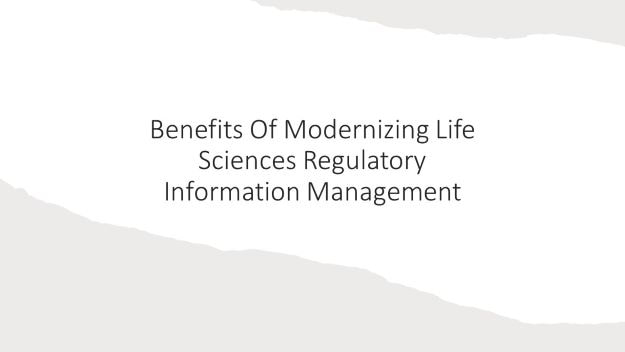Reduction of operational complexity
Regulatory Information Management (RIM) is a key component of regulatory compliance. The right solution can streamline the processes and reduce human error. With automated workflows and notifications, regulatory teams can assign tasks quickly and accurately, while reducing the burden on their teams. The right system also helps prevent the creation of duplicate documents.
Compliance is a complex process in the life sciences industry and using RIMS solutions can make the process easier. These solutions will help organizations stay up to date with regulations and plan their compliance strategies. Because these regulations are constantly changing and have varying timelines, companies can benefit from an integrated system. A cloud-based RIM solution will also enable real-time information sharing and harmonize global processes.
To create a high-performance regulatory organization, organizations must establish clear organizational structures. Governance must be streamlined. Scientific organizations tend to resist consensus decisions and need leaders who are comfortable making decisions that move the organization forward. Lastly, best practices recommend adopting a performance management system that will empower leaders to make informed decisions while developing the next generation of leaders.
Improved data quality
For the last decade, leading life sciences companies have focused on modernizing their regulatory information management (RIM) systems and processes. They are focusing on new digital business opportunities, improving data exchange with the enterprise, and revisiting roles and organizational structures to facilitate better patient access to data and information.
Modernizing life sciences RIM systems can make a significant impact on the quality of data collected. By eliminating redundant data entry and redundant queries, organizations can make decisions based on accurate and timely data. These systems also allow multiple contributors to work in parallel, allowing for real-time collaboration.
The underlying architecture of modernizing life sciences regulatory information management systems is flexible and can support millions of information segments. This architecture allows life science companies to save time and money as they develop and maintain their regulatory information. This approach is based on standards that are coupled and reusable.
Simplicity of processes
The pharma industry faces a number of challenges related to the management of regulatory information. The problem is compounded by disparate systems and software solutions that do not integrate. With the growth of global markets and the increasing number of stakeholders, the complexity of regulatory information has multiplied. Additionally, process dependencies have increased, leading to delayed submissions and market launch of drugs.
To keep up with the ever-changing regulatory landscape, it is essential to make the processes as simple as possible. Lean and Kaizen methodologies as well as value stream mapping provide many opportunities for improving processes. Current initiatives include enforcing standard identification for medicinal products, implementing clinical trial registration initiatives, and providing fast health information resources.
With structured content management, regulatory professionals can respond to sudden events in a fast and efficient manner. In addition to allowing regulatory professionals to respond more efficiently to sudden events, structured content management also automates the creation of study plans.
Savings in time and money
Modernizing life sciences regulatory information management is a great way to streamline processes while saving time and money. Instead of sourcing information from different departments and manually compiling it, companies can create one unified system with re-usable content. By utilizing standards that are coupled together, life science companies can save time and money while enhancing document quality and speeding up regulatory interactions.
Today's life sciences companies face a multitude of challenges, including rapidly rising costs, a growing number of regulatory bodies, and increasingly complex clinical trials and public disclosure requirements. These challenges can make it challenging for any organization to manage its regulatory information assets effectively. The industry spends several billion dollars annually managing content and information assets.
In addition to helping organizations manage regulatory data and regulatory compliance, these systems can streamline the entire regulatory process, including reporting and planning. In some cases, a single system can support multiple users across different countries and provide global transparency into upcoming regulatory activities.
Tip: I’ve a separate post touching upon transition from CSV to CSA. You may check it out here.
Related Reading:
- Operational Excellence FAQ: Why should you modernize regulatory information management in life sciences organizations?
- Challenges in Modernizing Life Sciences Regulatory Information Management Systems
- USFDA Guidance on Life Sciences Regulatory Information Management
- Economic Impact of Life Sciences Regulatory Information Management
- What are the drawbacks if Regulatory Information Management (RIM) of life sciences organizations is not modernized?
- Modernize regulatory information management to improve operational excellence in life science organizations
- How to Overcome Challenges in Life Sciences Regulatory Information Management
- Transitioning from Computer Software Validation (CSV) to Computer Software Assurance (CSA)
Follow Shruti on Twitter, Facebook, YouTube, LinkedIn
Categories: Life Sciences | Operational Excellence | Continuous Improvement
Keywords and Tags:
#CSAguidelines #computersoftwareassurance #CSVguidelines #CSVtoCSA #lifesciences #continuousimprovement #operationalexcellence #continuousimprovementforlifescienceindustry #changemanagement #cGMP #cGLP #cGAMP #goodmanufacturingpractices #goodlaboratorypractices #goodautomatedmanufacturingpractices





















